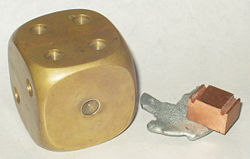Alloy
If a metal is combined with other chemical elements (metallic or nonmetallic) to form a solution or compound, and if the combination has metallic properties, the resulting material is called an alloy. Generally, a number of properties of the alloy are significantly different from those of its components. An alloy with two components is called a binary alloy, one with three is a ternary alloy, one with four is a quaternary alloy.
Some common alloys are brass, bronze, and steel. Some alloys are named after their primary constituent. For example, the "silver" used in jewelry and the "aluminum" used as a structural building material are actually alloys. Alloys of gold are rated on a scale of carats—for instance, 14 carat gold is 58% gold. The term "alloy" is sometimes used loosely as a synonym for "aluminum alloy," such as when referring to "alloy wheels" fitted on automobiles.
General properties
Alloys are usually designed to have properties that are more desirable than those of their constituents. For instance, steel is stronger than iron, its main element. The alloy "inherits" some of the characteristics of the elements it was made from—usually properties such as density, reactivity, and electrical and thermal conductivity. By contrast, properties such as tensile strength, Young's modulus, and shear strength can differ vastly from those of its constituent materials. These differences are caused by various factors, including the packing of atoms of differing sizes within the alloy. Larger atoms exert a compressive force on neighboring atoms, and smaller atoms exert a tensile force on their neighbors. Consequently, an alloy tends to resist deformation more than a pure metal, in which the atoms are freer to move.
Unlike pure metals, most alloys do not have a sharp melting point. Instead, they melt over a temperature range in which the material is a mixture of the solid and liquid phases. The temperature at which melting begins is called the solidus, and that at which melting is complete is called the liquidus. For most pairs of elements, however, there is a single, sharp melting point when the elements are in a particular ratio, called a eutectic mixture.
Some common alloys
Amalgam
Any alloy of mercury is called an amalgam. Most metals are soluble in mercury, but some (such as iron) are not. Amalgams are commonly used in dental fillings because they have been relatively cheap, easy to use, and durable. In addition, until recently, they have been regarded as safe. They are made by mixing mercury with silver, copper, tin, and other metals. The mercury content of dental fillings has recently stirred controversy, based on the potentially harmful effects of mercury.
Mercury amalgams have also been used in the process of mining gold and silver, because of the ease with which mercury amalgamates with them. In addition, thallium amalgam is used as the liquid material in thermometers, because it freezes at -58°C, whereas pure mercury freezes at -38°C.
Brass
Brass is the term used for alloys of copper and zinc in a solid solution. It has a yellow color, somewhat similar to gold. It was produced in prehistoric times, long before zinc was discovered, by melting copper with calamine, a zinc ore.
The amount of zinc in brass varies from 5 to 45 percent, to create a range of brasses each with unique properties[1]. By comparison, bronze is principally an alloy of copper and tin.[2]. Despite this distinction, some types of brasses are called bronzes.
Brass is relatively resistant to tarnishing and is often used for decorative purposes. Its malleability and acoustic properties have made it the metal of choice for brass musical instruments such as the trombone, tuba, trumpet, and euphonium. Although saxophones and harmonicas are made out of brass, the saxophone is a woodwind instrument, and the harmonica, a free reed aerophone. In organ pipes designed as "reed" pipes, brass strips are used as the "reed".
Aluminum makes brass stronger and more corrosion resistant. It forms a transparent, self-healing, protective layer of aluminum oxide (Al2O3) on the surface. Tin has a similar effect and finds its use especially in seawater applications (naval brasses). Combinations of iron, aluminium, silicon and manganese make brass resistant to wear and tear.
Bronze
Bronze refers to a broad range of copper alloys, usually with tin as the main additive, but sometimes with other elements such as phosphorus, manganese, aluminum, or silicon. It is strong and tough and has myriad uses in industry. It was particularly significant in antiquity, giving its name to the Bronze Age.
The introduction of bronze was significant to any civilization that encountered it. Tools, weapons, armor, and various building materials like decorative tiles made of bronze were harder and more durable than their stone and copper predecessors. In early use, the natural impurity arsenic sometimes created a superior natural alloy, called arsenical bronze.
With the exception of steel, bronze is superior to iron in nearly every application. Although bronze develops a patina, it does not oxidize beyond the surface. It is considerably less brittle than iron and has a lower casting temperature.
Copper-based alloys have lower melting points than steel and are more readily produced from their constituent metals. They are generally about 10 percent heavier than steel, although alloys using aluminium or silicon may be slightly less dense. Bronzes are softer and weaker than steel, Bronze springs are less stiff (and so store less energy) for the same bulk. It resists corrosion (especially seawater corrosion) and metal fatigue better than steel and also conducts heat and electricity better than most steels. The cost of copper-base alloys is generally higher than that of steels but lower than that of nickel-base alloys.
Copper and its alloys have a huge variety of uses that reflect their versatile physical, mechanical, and chemical properties. Some common examples are the high electrical conductivity of pure copper, the excellent deep-drawing qualities of cartridge case brass, the low-friction properties of bearing bronze, the resonant qualities of bell bronze, and the resistance to corrosion by sea water of several bronze alloys.
In the twentieth century, silicon was introduced as the primary alloying element, creating an alloy with wide application in industry and the major form used in contemporary statuary. Aluminium is also used for the structural metal Aluminium bronze.
Bronze is the most popular metal for top-quality bells and cymbals, and more recently, saxophones. It is also widely used for cast metal sculpture (see bronze sculpture). Common bronze alloys often have the unusual and very desirable property of expanding slightly just before they set, thus filling in the finest details of a mould.
Bronze also has very little metal-on-metal friction, which made it invaluable for the building of cannons where iron cannonballs would otherwise stick in the barrel. It is still widely used today for springs, bearings, bushings and similar fittings, and is particularly common in the bearings of small electric motors. Phosphor bronze is particularly suited to precision-grade bearings and springs.
Bronze is typically 60% copper and 40% tin. Alpha bronze consists of the alpha solid solution of tin in copper. Alpha bronze alloys of 4-5% tin are used to make coins, springs, turbines and blades.
Commercial bronze (otherwise known as brass) is 90% copper and 10% zinc, and contains no tin. It is stronger than copper and it has equivalent ductility. It is used for screws and wires.
Pewter
Solder
Steel
List of alloys
This is a list of alloys grouped by the main metallic constituent, in order of increasing atomic number of the main metal. Under these headings, the alloys are in no particular order. Some of the main alloying elements are optionally listed after the alloy names.
Alloys of aluminum
- Al-Li (lithium, mercury)
- Duralumin (copper)
- Nambe (seven undisclosed metals)
- Magnox (magnesium oxide)
- Zamak (zinc, magnesium, copper)
- Silumin (silicon)
Alloys of potassium
- NaK (sodium)
Alloys of iron
- Steel (carbon)
- Stainless steel (chromium, nickel)
- AL-6XN
- Alloy 20
- Celestrium
- Marine grade stainless
- Martensitic stainless steel
- Surgical stainless steel (chromium, molybdenum, nickel)
- Silicon steel (silicon)
- Tool steel (tungsten or manganese)
- Bulat steel
- Chromoly (chromium, molybdenum)
- Crucible steel
- Damascus steel
- HSLA steel
- High speed steel
- Maraging steel
- Reynolds 531
- Wootz steel
- Stainless steel (chromium, nickel)
- Iron
- Fernico (nickel, cobalt)
- Elinvar (nickel, chromium)
- Invar (nickel)
- Kovar (cobalt)
- Spiegeleisen (manganese, carbon, silicon)
- Ferroalloys (category:Ferroalloys)
- Ferroboron
- Ferrochrome
- Ferromagnesium
- Ferromanganese
- Ferromolybdenum
- Ferronickel
- Ferrophosphorus
- Ferrotitanium
- Ferrovanadium
- Ferrosilicon
Alloys of cobalt
Alloys of nickel
- German silver (copper, zinc)
- Chromel (chromium)
- Hastelloy (molybdenum, chromium, sometimes tungsten)
- Inconel (chromium, iron)
- Mu-metal (iron)
- Monel metal (copper, nickel, iron, manganese)
- Nichrome (chromium, iron, nickel)
- Nicrosil (chromium, silicon, magnesium)
- Nisil (silicon)
- Nitinol (titanium, shape memory alloy)
- Copper-Nickel (bronze, copper)
Alloys of copper
- Beryllium copper (beryllium)
- Billon (silver)
- Brass (zinc)
- Bronze (tin, aluminium or any other element)
- Constantan (nickel)
- Corinthian brass (gold, silver)
- Cunife (nickel, iron)
- Cupronickel (nickel)
- Cymbal alloys (Bell metal) (tin)
- Devarda's alloy (aluminium, zinc)
- Hepatizon (gold, silver)
- Heusler alloy (manganese, tin)
- Manganin (manganese, nickel)
- Nickel silver (nickel)
- Nordic gold (aluminium, zinc, tin)
- Shakudo (gold)
- Tumbaga (gold)
Alloys of gallium
- Galinstan
Alloys of silver
Alloys of tin
Rare earth alloys
- Mischmetal (various rare earths)
Alloys of gold
Alloys of mercury
Alloys of lead
Alloys of bismuth
- Wood's metal
- Rose metal
- Field's metal
- Cerrobend
Alloys of zirconium
- Zircaloy
See also
ReferencesISBN links support NWE through referral fees
External links
- National Pollutant Inventory - Copper and compounds fact sheet
- 19th century bronze sculpture sand casting
- Bronze Casting process explained
- The source of tin for ancient bronze production
- Information about Bronze Tiles
Credits
New World Encyclopedia writers and editors rewrote and completed the Wikipedia article in accordance with New World Encyclopedia standards. This article abides by terms of the Creative Commons CC-by-sa 3.0 License (CC-by-sa), which may be used and disseminated with proper attribution. Credit is due under the terms of this license that can reference both the New World Encyclopedia contributors and the selfless volunteer contributors of the Wikimedia Foundation. To cite this article click here for a list of acceptable citing formats.The history of earlier contributions by wikipedians is accessible to researchers here:
The history of this article since it was imported to New World Encyclopedia:
Note: Some restrictions may apply to use of individual images which are separately licensed.


